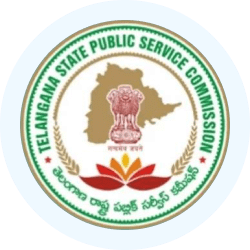Kamareddy - 3 | Telangana State PSC (TSPSC): Preparation Course - TSPSC (Telangana) PDF Download
Tourist Places
Koulas Fort Koulas (V), Jukkal (M)

- The village of Kowlas, located in Jukkal Mandal of Kamareddy District, holds historical significance. Legend has it that Kowlas was originally named 'Kailas', as the Kakatiya rulers established five Sivalingas in its five corners. In ancient times, the collective territories of Kowlas, Bodhan, and Nizamabad were referred to as Indur.
- Constructed during the 9th Century CE by the Rashtrakutas, Kowlas Fort was later seized by the Chalukyas of the Kalyani dynasty in the latter part of the 10th Century CE. Subsequently, the fort fell into the hands of the Kakatiyas of Warangal and remained a part of the Kakatiya kingdom until 1323 CE. With the arrival of Muslim rulers, control of the fort passed through various dynasties including the Bahamanis, Qutb Shahis, Naikwaries, Mughals, Marathas, and finally, the Asaf Jahis.
- Raja Gopal Singh Gour was appointed as the Raja of Kowlas, and his descendants maintained control over the fort until 1947 CE. Spanning approximately one kilometer in length and seven hundred meters in width, the fort boasts 52 bastions, three temples (Venkateswara temple, Ramalayam, and Mahadev temple), two mosques, five wells, four granaries, and additional structures like Rani Mahal and Elephant Well (Enugula Bavi).
- The Jagdamba Bhawani cannon, also known as Navgarji Tope, was the largest cannon of its time in the world, made by Raja Gopal Singh in the year 1728 CE. Inside the Fort, there are five more cannons.
- The Koulas Fort, a massive structure dating back to the 14th century, covers an area of 6 square kilometers and is located in Jukkal mandal near the Bidar – Nanded road. Originally built by the Kakatiya rulers, the fort was subsequently conquered by Muslim rulers such as the Bahamanis, Qutb Shahis, and later occupied by the Nizams.
- Constructed in the semi-Dravidian style at an altitude of about 1100 feet, the fort is surrounded by a natural moat created by a stream. Its vast area is enclosed by a formidable fortification wall with strong bastions. Inside, visitors can explore numerous gateways, buildings, temples, mosques, and other structures. The fort is adorned with around 20 large cannons and features 52 small and big bastions, along with several water tanks. The fort temple and dargah have been designated as protected monuments by the Archaeology Department.
- The Kasikund temple, modeled after the Kasi temple, is one of the notable structures within the fort. Additionally, there are temples dedicated to Rama, Hanuman, and Balaji. Behind the fort lies the Ashtabuji Mata, also known as Jagadamba Mata temple. Unfortunately, the fort's current state of maintenance is poor, and the approach route is often overgrown with thorns. During the monsoon season, when the water levels in the stream rise, the fort becomes inaccessible.
- To reach the Koulas Fort, visitors need to trek approximately 250 meters. It is advisable to hire a local villager as a guide from Koulas village to navigate the route to the fort. Additionally, the Koulas dam, located about 20 kilometers away from the fort, is a popular spot for birdwatching, particularly during the winter months.
How to Reach
- Currently, there is no operational airport in Kamareddy. The nearest airport is the Rajiv Gandhi International Airport in Hyderabad, situated 168km away.
- To reach Kamareddy from Secunderabad (SC) or Kacheguda (KCG), you can take a train. The journey from Secunderabad to Kamareddy by train typically lasts around 2 hours and 15 minutes. Kamareddy is linked to Hyderabad, the capital city of Telangana, which is roughly 113 km away, via rail transport.
- Koulas village is positioned 10 km from Jukkal mandal headquarters, which is around 97 km from the district headquarters of Kamareddy District. Situated near Koulas village in Kamareddy district, Koulas Fort is 3 km away from Koulas, 81 km from Nizamabad, 84 km from Medak, and 169 km from Hyderabad.
Domakonda Fort, Domakonda (V) & (M)
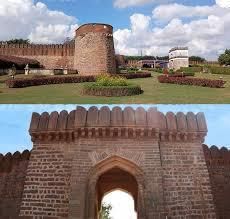
- Domakonda Fort is situated in Domakonda village within the Kamareddy district of Telangana. Constructed in the 18th century, this fort features an elevated compound made of granite rocks forming the fort wall. The entrance is marked by a wooden door leading into a stunning two-storied fort structure. The fort is renowned for its exquisite stuccowork, which remains visually captivating even today.
- This fort, also known as "Gadi Domakonda" or "Killa Domakonda," encompasses a palatial mahal referred to as "Addhala Meda" or Glass House. The magnificent bungalow includes a courtyard adorned with a water garden pond and granite pillars firmly rooted into the ground to protect the pond. The ground floor boasts arched pillars with intricate stuccowork reflecting Mughal architectural influences, while the first floor features round pillars and a flat ceiling indicative of Western architectural styles. Domakonda Fort stands as a remarkable architectural marvel, offering a glimpse into the grandeur of Telangana's heritage. Presently, the fort remains under the administrative oversight of the royal families of Domakonda.
- Domakonda is accessible via a 4 km diversion from the main road en route to Nizamabad from Hyderabad (NH7), approximately 100 km away from Hyderabad. Additionally, the fort complex houses a Shiva temple constructed by the Kakatiya rulers.
Domakonda Shivalaya temple
- The Domakonda Shivalaya temple is the oldest surviving structure in the area, believed to date back to the Kakatiyan period. Situated to the east of the fort, this temple, also known as the Mahadev Temple, is estimated to be around 750 to 800 years old. In 2006, with the assistance of the Department of Archaeology, Government of Telangana, the temple underwent restoration work.
- Today, it stands as a fully functional temple dedicated to Lord Shiva. Preserving age-old traditions, the villagers of Domakonda gather at the temple every year to celebrate Shivaratri with immense enthusiasm and fervor.
How to Reach
- Nearest airport is Rajiv Gandhi International Airport in Hyderabad, 168km away from Kamareddy.
- Train travel from Secunderabad to Kamareddy takes about 2 hours and 15 minutes.
- Car journey from Hyderabad to Kamareddy covers 117km in approximately 2 hours and 45 minutes.
- Bus services available from Kamareddy to Secunderabad(JBS) and Hyderabad(MGBS) operated by TSRTC.
Question for Kamareddy - 3Try yourself: What is the historical significance of Koulas village in Kamareddy District?View Solution
Nizam Sagar Dam, Nizamsagar (V) & (M)
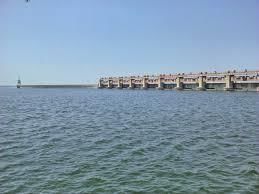
- There are numerous attractions and experiences awaiting tourists in Kamareddy. To fully appreciate the beauty of this town, it is essential to be well-informed before embarking on your journey. A comprehensive travel guide can assist in addressing most of your queries regarding your visit to Kamareddy. To navigate the roads of Kamareddy smoothly, it is crucial to identify the key places to explore and the optimal time to plan your trip. Armed with this knowledge, you can ensure a delightful excursion to Kamareddy. One prominent tourist destination is the Nizam Sagar Dam, a reservoir built across the Manjira River. The Manjira River, a tributary of the Godavari, meanders between the villages of Achampet and Banjapalle in the Kamareddy district of Telangana, India. The drinking water sourced from this reservoir is vital in meeting the water requirements of Hyderabad and Secunderabad. Nizam Sagar stands as the oldest dam in Telangana state.
- This location is situated approximately 145 kilometers northwest of the state capital Hyderabad and 81 kilometers from Nizamabad District. The Nizamsagar dam was constructed in 1923 under the patronage of Mir Osman Ali Khan, the then ruler of the Hyderabad state. The construction of the dam necessitated the relocation of people from 40 villages in the area. Over the years, it has become renowned as one of the world's notable tourist destinations.
- Prominent figures such as Mahatma Gandhi and Pandit Jawaharlal Nehru visited this site during the 1940s, adding to its historical significance. Nearby the dam, there are excellent lodging and boarding facilities available to accommodate tourists.
- The Nizam Sagar Project marks the second irrigation scheme on the Manjira River. Following the reorganization of states in 1956, the Manjira basin was divided among the three states of Telangana, Maharashtra, and Karnataka.
How to Reach
- Currently, there is no operational airport in Kamareddy. The nearest airport is the Rajiv Gandhi International Airport in Hyderabad, situated 168km away.
- To reach Kamareddy from Secundrabad (SC) or Kacheguda (KCG), you can take a train. The journey from Secundrabad to Kamareddy by train typically lasts around 2 hours and 15 minutes.
- Nizam Sagar Dam is positioned approximately 85 km from Nizamabad town and 145 km from Hyderabad, accessible by road.
Culture & Heritage
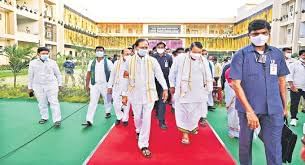
- Kamareddy, located in the Kamareddy district of Telangana, boasts several religious and heritage sites that trace back to ancient times. One notable attraction is the Domakonda Fort, constructed during the 18th century, offering insight into the city's rich historical and cultural heritage.
- The culture of Kamareddy is characterized by its vibrant dance, music, cuisine, and art forms. Traditional dances such as Lambadi, bonalu, kolattam, bathukamma, and burrakatha are popular here. The religious landscape includes a diverse mix of Hindu temples, Muslim mosques, and worship sites of tribal communities who revere nature.
- Some prominent temples in Kamareddy include the Sri Prasanna Venkateswara Panchamukhi Hanuman Temple, Sri SomaLingeswara Swamy Temple in Durki, Sri Sai Baba temple, Sri Anjaneya Swamy Temple in Salabatpur, Sri Kala Bhairava Swamy Temple in Issanapally, Sri Laxmi Narasimha Swamy Temple in Chukkapur, and Sri Siddarameshwara Temple in Bhiknoor Village & Mandal, among others.
- Kamareddy's rich historical legacy is reflected in its diverse cultural traditions. Festivals are celebrated with great fervor, offering visitors a glimpse into the city's celebratory spirit.
- The district also boasts prehistoric sites, including evidence of a developed megalithic culture found in Yellareddy and Kamareddy. Throughout history, Kamareddy has been ruled by various dynasties, including the Mauryas, Satavahanas, Kakatiyas, Bahmani Sultanate, Qutub Shahis, Bidar Sultanate, Mughals, and Asaf Jahis.
- Kamareddy is well-connected to Hyderabad, the capital city of Telangana, by road and rail. Kamareddy Railway Station serves as a major transportation hub, while Shamshabad International Airport, located approximately 167 km away, provides air connectivity. The Telangana State Road Transport Corporation offers bus services from Hyderabad, Nizamabad, and Nagpur.
- With a semi-arid climate, Kamareddy experiences temperate conditions during the winter months, making December to February the best time to visit.
Question for Kamareddy - 3Try yourself: What is the main purpose of the Nizam Sagar Dam?View Solution
Culinary Delights
Pachi Pulusu
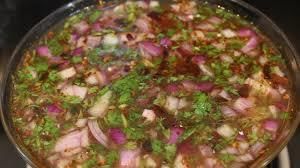
- Pachi Pulusu, a traditional dish popular in Kamareddy and other districts of Telangana, is a refreshing summer delicacy. Unlike its hot counterpart, this version of tamarind soup is served unheated, making it perfect for hot weather.
- To prepare Pachi Pulusu, tamarind juice is combined with onions, dried red chilies, cumin seeds, curry leaves, and jaggery to create a spicy, tangy, and slightly sweet stew. The dish is not cooked except for the tempering process. The tempering typically involves heating oil and adding mustard seeds, garlic, and green chilies, although variations in tempering ingredients may exist depending on regional preferences.
- In some regions of Telangana, jaggery may not be used, while green chilies are used instead of dried red chilies to adjust the spice level. The addition of jaggery helps balance the tangy flavor of tamarind, while the use of green chilies adds a fresh and vibrant kick to the dish.
- Overall, Pachi Pulusu is a light and flavorful dish enjoyed during the summer months, offering a delightful combination of spicy, tangy, and sweet flavors.
Garijalu
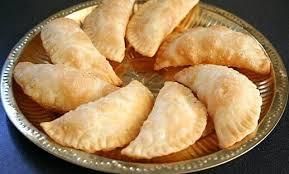
- The outer pastry of these delectable half-moon dumplings is crafted from plain flour. Popularly known as Kajjikaya, this treat features a sweet filling comprising dry grated coconut, sugar, and optionally, a hint of cardamom.
- After being deep-fried, the crispy shell is created from maida, which is rolled into a circle before frying. This beloved sweet has been savored by generations through the ages.
Jonna Rotte

- The traditional dish of the Kamareddy regions is Jonna Rotte, a flatbread made with sorghum. Jowar, a major crop in most Telangana districts, is the primary ingredient in Jonna Rotte, a staple food in Kamareddy villages.
- This dish is typically consumed as a light dinner option and is renowned for its high protein and fiber content, making it one of the healthiest food choices.
Sarva Pindi

- Sarva Pindi, a renowned breakfast delicacy originating from Kamareddy, Telangana, is a savory pancake crafted from a blend of rice flour, chana dal, ginger, garlic, sesame seeds, curry leaves, and green chilies. This mixture of grains, pulses, and spices imparts a rich and flavorful taste to the dish, making it a favorite among locals.
- To prepare Sarva Pindi, the dough mixture is flattened and cooked in a deep, round-shaped pan. To maintain the authenticity of the recipe, it is essential to create small holes in the rolled-out dough before cooking. This step ensures even cooking and allows the flavors to infuse thoroughly into the pancake.
- The unique combination of ingredients in Sarva Pindi results in a delightful culinary experience, with each bite offering a perfect balance of textures and flavors. Whether enjoyed as a breakfast staple or as a snack, Sarva Pindi remains a cherished part of Telangana's culinary heritage.
Question for Kamareddy - 3Try yourself: What is the primary ingredient used in the traditional dish of Jonna Rotte?View Solution
The document Kamareddy - 3 | Telangana State PSC (TSPSC): Preparation Course - TSPSC (Telangana) is a part of the TSPSC (Telangana) Course Telangana State PSC (TSPSC): Preparation Course.
All you need of TSPSC (Telangana) at this link: TSPSC (Telangana)
|
80 docs|74 tests
|
FAQs on Kamareddy - 3 - Telangana State PSC (TSPSC): Preparation Course - TSPSC (Telangana)
| 1. What are some popular tourist places to visit in Kamareddy? |  |
Ans. Some popular tourist places to visit in Kamareddy include historical sites, temples, and natural attractions such as Kotilingeshwara Temple, Venkatapur Dargah, and Manjeera Dam.
| 2. How can one experience the culture and heritage of Kamareddy? |  |
Ans. One can experience the culture and heritage of Kamareddy by visiting the local markets, attending traditional festivals, and exploring historical monuments in the region.
| 3. What are some culinary delights to try in Kamareddy? |  |
Ans. Some culinary delights to try in Kamareddy include traditional Telangana cuisine such as Biryani, Hyderabadi Dum Pukht, and Mirchi Bajji.
| 4. Is Kamareddy known for its cultural and heritage significance? |  |
Ans. Yes, Kamareddy is known for its rich cultural and heritage significance, with a history dating back to ancient times and a vibrant local culture that is celebrated through various festivals and traditions.
| 5. Are there any specific dishes or food items that Kamareddy is famous for? |  |
Ans. Yes, Kamareddy is famous for its unique dishes such as Jonna Rotte, Gongura Pachadi, and Ariselu, which are popular among locals and tourists alike.
Related Searches


